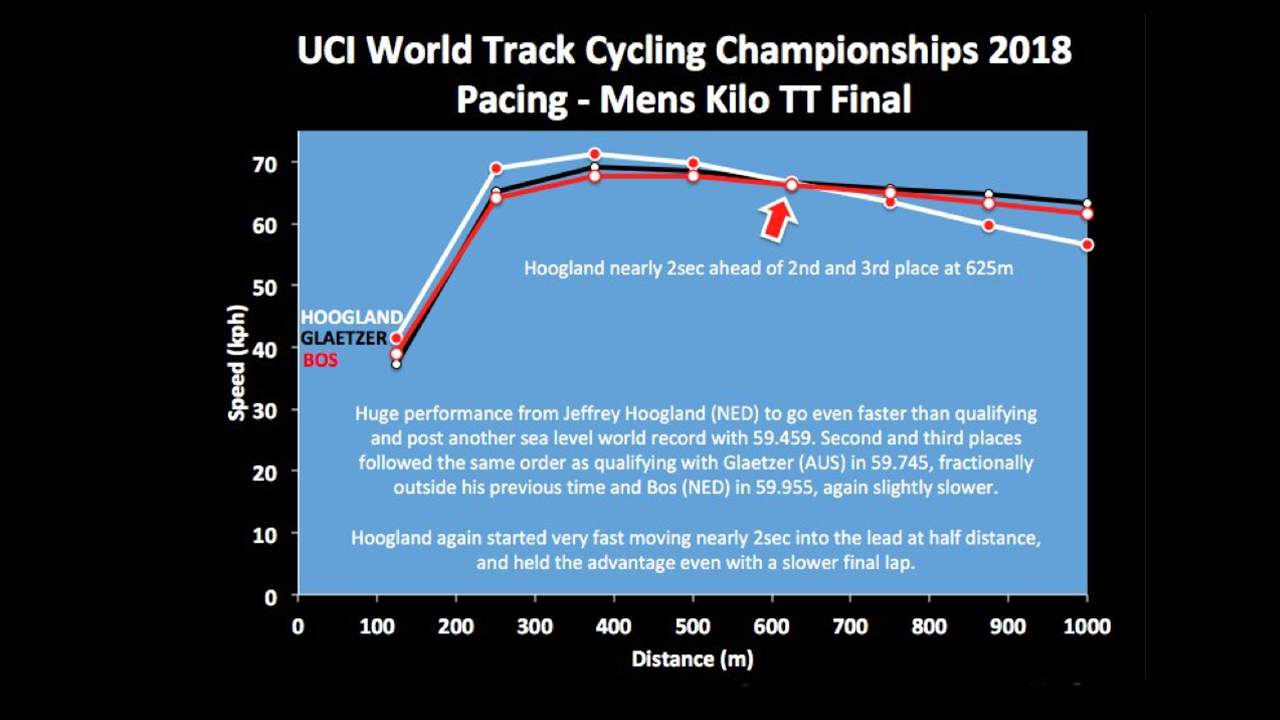WORLDS: High Speeds & Fast Finishes

“Did you see Chris Hoy’s post on Twitter?” asked Shane Perkins in a conversation yesterday. “No” I said, what did he write?”…
Sir Chris described the amazing performances by Jeffrey Hoogland, Matthew Glaetzer and Theo Bos, all of whom rode their 1km (called the kilo) time trial in under 1 minute at the World Championships. Jeffrey Hoogland’s 59.459 is a sea-level world record and won him the gold medal.
The eight points on the graph represent the half-lap splits. It shows that after one full lap not one of the three riders is up to the maximum speed achieved as the point at 375m is the highest, leaving two-and-a-half laps of reducing speed. Reducing speed, slowing down, sounds a lot more relaxed than any ride averaging over 60kmh could possibly be.
The shape of the graph is similar to a graph of wattage of a 30 second anaerobic power test, in that it ramps up to its peak and declines before the end. Wattage and speed won’t match exactly, as there are other physical forces at play, in that if the rider freewheeled or unclipped – clearly neither is possible unless something hasn’t quite worked, we know - the wattage would drop to zero but the speed would reduce more gradually.
That technique, on a road bike, is a cheap alternative to a wind-tunnel or power meter. Reach and hold a speed, stop pedalling and see how far your travel. Or see how far you get before losing half the speed achieved, to avoid being down to walking speed in a full aero position, looking mildly ridiculous to anybody passing. This is like something from school science. Obviously the terrain and wind would have to be equal on all efforts but, as motion is constant unless acted upon by an external force, thank you Mr Isaac Newton, the further you travel after stopping pedalling the less resistance there must have been. Certainly equipment will come in to play (well maintained wheels etc) but the faster you are travelling the greater the percentage of resistance comes from air resistance. It’ll probably merely prove that sitting up straight isn’t aero and why wind tunnels are used. Anyway…
The graph represents two approaches to the kilo. The higher maximum speed, despite the higher percentage in speed lost during the effort, won the day. When all the riders shown went under a minute it would be a bit much to announce that the blueprint for success has been produced. Sir Chris described bigger gears being used by Matthew Glaetzer and Theo Bos and so reminding us that there are choices of how to approach this, and all other events for that matter. Taylor Phinney was interviewed a while ago and reminded us that the Individual Time-Trial has a clue in the title. It is individual. There are many approaches which might bring success, making it all the more enjoyable for those of us who watch, and giving freedom to wonder what we might try next when we ride.
Image Credit: Xavier Disley via Twitter
Blog written by Michael Jordan (Physiological Performance Analyst, Track Cycling Academy)
Feel free to leave any comments or questions in the box below! As always - we love hearing from you!



